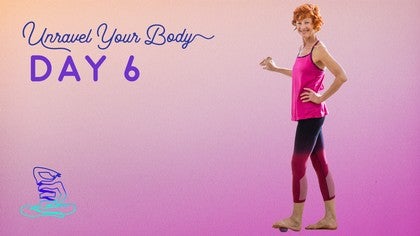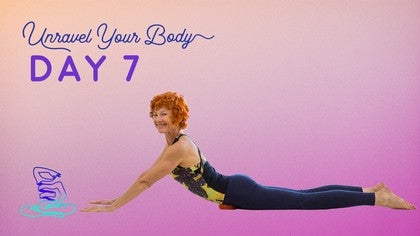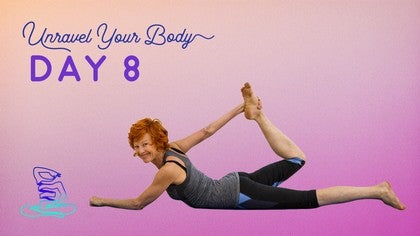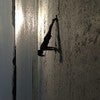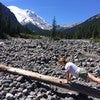Description
About This Video
Transcript
Read Full Transcript
Oh, welcome. Today six we're going to be unraveling the shinbones and the feet and restoring a sense of springiness into the lower body. Our lower bodies have a tendency to get really jammed up. We're in shoes. All the weight of our bodies is always pressing down and there's a solidification and hardening that happens that we are going to be addressing and turning around. So retest, lifting the toes, lifting the heels, lifting the toes, lifting the heels, and then just slightly, how much of a spring having a spring in our step is a very functional description of what we're supposed to be able to do. And what did that feel like?
And then just having a look to see how much range of movement is there in the feet. Can you walk on your heels? Sometimes a bit surprising. Can you walk on your toes without high heels? Just literally there. So those are just little tests to see. What did you feel? I feel like with a wobbly where they lose, where they kind of springy, which is the goal with a stable, with a weak and flimsy and disjointed because we're going to work on them.
So we're working with the yoga too. Nepal's here you can use a tennis ball for sure. These balls soften up. You can use the any ball. Really the concept is just roll your feet out and to begin with, I am placing it just below the ball of the foot with my heel down. I am definitely holding onto the wall.
So my weight is more on my back leg and keeping the heel on the floor. I'm starting to roll my big toe towards the floor so I'm fanning my foot across this ball because our feet get flattened out and you lose this ability to actually be rolling and adjusting to uneven terrains because we're in shoes all the time and if we walk, we usually on flat surfaces, but we're not designed to be flat surface creatures. We're designed to adapt and an even terrain and catch our balance and we want to restore all that flexibility and mobility. So moving onto the middle of the arch still. I'm trying to keep my heel down. Maybe you can't, but the same principle, inner part of the foot now, inner heel and big toe, outer part of the foot, just rolling through, looking to get as much of this rolling motion of the foot as you possibly can get.
Sometimes you can feel the tissue is very tight under there. It should feel lovely, wants the bodies let go of whatever fixed conditions and structures it has. It's also a lot of acupressure points for the rest of the body. So sometimes if you find a really painful point, bravo because it's good to release it. Now coming onto the heel, I'm actually not on my heel, I'm just before the heel and again, rolling the foot out, rolling the foot in.
So it's a bit of a strange feeling because we're always so concerned with PR, pronation and supination and trying to keep the arch lifted. But we want this adaptability and flexibility to shift the shape and it will restore the spring Archie look and feel of the foot. Now. The other thing is it's right in front of my heel and now I am like a fan rotating from side to side, kind of massaging all the tendon and attachments before the heel and then rolling through from my heel to the big toe. Now I'm going to the second toe to the third toe to the fourth hole to the fifth, so bringing the ball back to the middle of the foot, stretching down and up, curling the toes and now a real fun one with the other foot stretching all of that tissue out. It's like pulling the skin down and then to work the toes a little bit.
The Big Toe and second toe is up lifting
So just below the ball of the foot, if you press down and look at your knuckles, if you have really good tarsals, you should be able to see the knuckles very often. That's not open, but it will improve. And again, rolling from side to side, massaging this fan like rotation of the um, wrapping the foot around the ball because the foot should be an arch. Um, it's got three arches and we want all of them to be lifted and like moving to the middle of the foot, I'm taking a moment to press into the middle of the foot. It can get really congested if you can keep your heel down and your toes down. If you have a big enough foot power to you, but it doesn't really matter, you can have your heel off. It's mostly rolling the outside of the foot to the floor, the inside of the foot to the floor, trying to make it come as much as possible. From your ankle.
I know there's a tendency to make the knee roll, but the goal is to restore this mobility in the ankle joint in the foot rather than in the joints above, which is where usually we repattern into going towards the segment just in front of the heel, out of foot in a foot. Oh, there's a nice stiff spot out, a foot in, a foot out of foot in a foot. Then keeping the ball in front of the heel, rolling from side to side, just massaging all of those attachments that go into the Hilo and then taking, you can go right to the middle of the heel and imagine that you running down that bony tarsal all the way to the big toll and you are, and each one of your toes has its own tarsal. Now I'm running through to the second toe. Can I see my metatarsal joint as I roll over it? And the third toe, this is one that very often gets sunk down. So right here I'll often bend down and stretch out that segment.
In my case, I need to stretch out this toe. There's my tar. So my metatarsal in there, it's a little bit collapsed and moving through to the fourth toe and then onto the the toe back with the ball more or less in the middle of the foot, curling the toes down, looking to stretch those tarsals out and up or they don't want to do it down and up and down. So I'm getting this ability of the foot to pals and squeeze and then stretching all the tissue at the top of the foot, which feels delicious but again can be quite stuck and and sliding. When you do this for the first time and the best part of all, just rubbing it out and walking through the toes. Big Toe and second toe lifting second and third tail. Let me straighten out my third toe.
That's a little twisted right now. So I encourage the bones to open up straight. Third and fourth toe is my dominant focus. Stretching. If it's really tight, you spend more time, fourth and fifth toe stretching. And just for fun, this is so good. Roll your ball out, your foot out again on the ball. It's just too good not to do. And then stand, see what your feet feel like right now. Where they more alive.
Sometimes they may be bright red because they opened up the circulation. That's good. Enjoy the feeling. So the next part is to release the Shin and the front of the foot can be a little bit extreme. So pace yourself also with the ball you can deflate the ball if it's too harsh. When you start, you want to place the ball right on the shinbone below the knee and just if you want to, you lean into it a little bit and then row the knee a little bit in.
So it's rolling into that section between the two bones and the Sherman, that Tibia and Fibula and out. So you massage, massaging, you're actually rolling with pressure. Cross a ball, moving a little bit further forward. This is where I start to rock back and forth, putting as much pressure as I can on the bone because the bone gets stuck and very rigid. Rolling in a little bit, rolling out any point that you find is extremely painful for you. Keep spend time there, revisit it. It will lighten up. The bone will get less impacted. Moving further forward and again, sitting down and rocky.
Now I have more of a seesaw motion available to me.
I just go with it because the relief is so extreme as the bone is released from the adhesions. And then the tissue go back state and a more lastic state. And again, rolling in. Now I can feel it pulling into the inside of my heel. So as the lower you on your leg you go, the more you can, the more probably sensation you're going to have cause there's more body weight and less um, fibrous muscle tissue to take it. Now I'm right in the crease of my ankle.
So this is where that joint is. Check to see that your foot is going straight back if possible. And a slightly out slightly in. This is where the, it's like a crossroad too. There's a lot more congestion and now we get into the really fun part, which is the top of the foot. I'm trying to control my foot.
It wants to completely roll in. There's nothing wrong with doing all the different angles your foot wants to. But today I'm trying to keep the foot straight to find it, move it through the most challenging parts. So now I'm just rolling across the top of the arch and starting to get out of the arch and into the tarsals right before the toes. This is where you need to love yourself a lot because it can get pretty painful because we never worked the toes down very much.
We only work them up inflection and they, the ligaments can get very tight and very separate. Those are the the s the shape and movement that you need for a jumpy spring, like feelings and moving all the way through the toes. I just felt them released. I hope you did too. Ah, yeah. Now my foot is opening and letting go of the rigidity all the way through. I hope you liked that.
Let your feet dangle just for a minute and or if you're on the floor, see what they feel like. If you look down, sometimes your foot is bright red, so moving onto the other leg, starting again, just like we did before, right? You can see the knobbly part of where the shinbone is connecting up, and then there's the fibula that running down the side. Now, very often, this section between these two bones get very fibrous tight adhesions, and frankly those two bones work as one unit, but they're designed to work independently. So we're looking to restore the stability of the two bones to interact and shift in relation to each other. Rolling out a little bit, rolling in a little bit. So just rolling across the bone. If you feel any, if we're really sticky and tight, push into it. If you're up for it. Moving further forward.
Now I'm going to start a little bit of a seesaw. This is literally a massage for your bones. It's so good for them and so good for the tendons and muscles. Um, and the interrelationship of all of this. The connective tissue, one to the other and again, rolling out, meaning the balls rolled out, my knees rolled in and or right across my shinbone I can feel a little bit of tightness in their fields. Really good. Now it's diminishing. Moving up, now I'm starting to get into more tension.
If you're a runner, um, or you're doing a lot of walking because again, the bones have gotten locked. The muscles are in spasms. This is a great way both to prevent it or to eventually work it out.
I'm almost at my ankle but not quite. Usually it becomes more extreme. The sensation and the tightness, the lower you go on the leg. So if that's your experience, you have a lot of company and again, rolling in, I'm bringing my knee in so the ball's rolling out, rolling across the bone to the inside.
So comfortable in any shape and any place. Moving further forward, now I can start to feel all the tightness across my toes and my torsos so I'm just giving them a little stretch, releasing, moving all the way through to the most extreme point. This is most commonly where it's quite intense because the toes are so unused to it. Ah, let's see if I can release. I hope they are releasing for you a little bit further just to give them more of a stretch. If it's extreme, don't go so deep and then rolling off. Just for a minute. I can feel my feet.
Breathe and then let go and stretch your legs out and have a look. My feet are knight. This foot is nice and red because of all the blood that's flushing through. So wasn't that fun. So now let's test and see what do I feed feel like after all of this.
Even standing on them for a minute, they have to recalibrate because there's so much more open and mobile. So let's see. Lifting the toes. What does that feel like? Lifting the heels, lifting the toes, lifting the heels. Can you stay balancing here? Wall, lifting the toes, lifting the heels and also the springy feeling. What does that feel like? Do you feel kind of more energy and then can you walk on your heel walking back on your toes?
Go out for a walk now and just be in your feet. It's a wonderful experience.
Unravel Your Body Challenge: with Niedra Gabriel
Comments
This is the first time I’ve rolled my shins though and it was a wonderful release. This is also going into my repertoire.
This series is such a blessing. Thank you.
The last two videos have us sitting on heels for lengthy periods of time to facilitate tissue release; however, I have a total knee replacement/reconstruction and sitting on my heels on that side is no longer a possibility - ever. I'm a Pilates teacher and have innovated a bit; however, this might be very limiting for those with knee issues.
There is always more to be done and if your knee does not bend you would of course, have to be creative to find ways to get pressure into a body part without needing the joint mobility. If you are working with someone ( assisting with this work) you can have them press the foot into the top of the ball ( or wherever you need the pressure but are not able to get it due to lack of knee mobility).
I hope this opens up your creative juices .
Knee problems - assuming you are referring to rolling out the shins? place a pillow between the calves and the bottom so they are sitting on the pillow not the heels - less extreme bend of the knee joint - hope this helps? let me know.
You need to be a subscriber to post a comment.
Please Log In or Create an Account to start your free trial.
